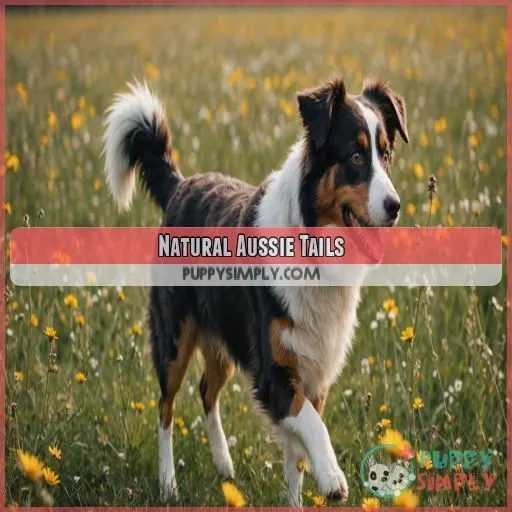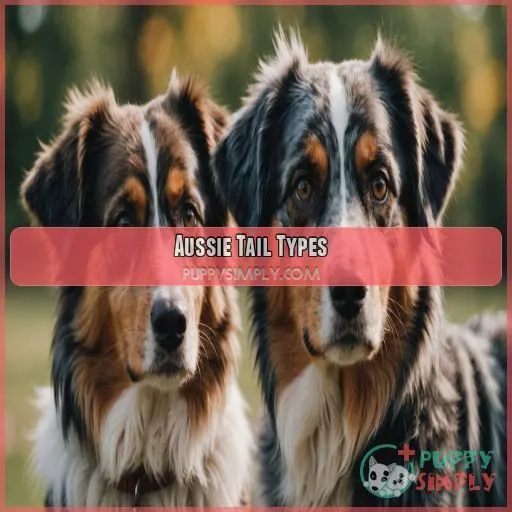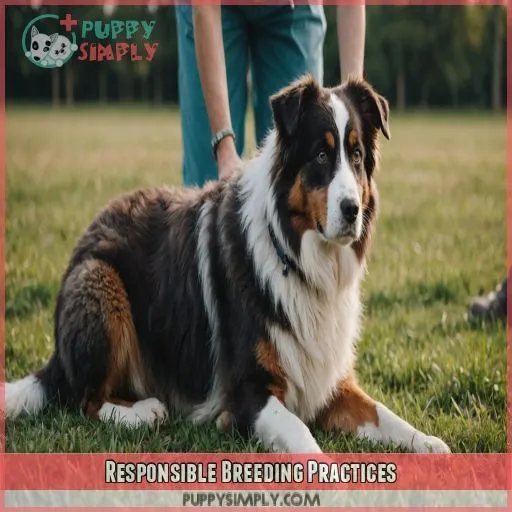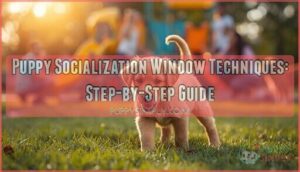This site is supported by our readers. We may earn a commission, at no cost to you, if you purchase through links.

Don’t worry, you’re not alone! As an Aussie owner, you know their enthusiasm can sometimes get the best of them, leading to painful tail injuries.
Identifying common tail injuries like cuts, lacerations, and fractures is really important.
If you’ve noticed whining, tucking, or reduced wagging, it’s time to take action.
Prioritize pain management and monitor for infection.
By taking the right steps, you can get your Aussie’s tail wagging in no time.
But what about preventing these injuries in the first place?
Table Of Contents
- Key Takeaways
- Australian Shepherd Tail Injuries
- Tail Docking Controversy
- Natural Aussie Tails
- Tail Health and Care
- Communication Through Tails
- Aussie Tail Types
- Breed-Specific Tail Concerns
- Responsible Breeding Practices
- Promoting Aussie Tail Welfare
- Frequently Asked Questions (FAQs)
- Can Australian Shepherds be born without tails?
- Do you crop Australian Shepherds tails?
- How do you treat a dog’s tail injury?
- What do Australian Shepherds tails look like?
- What are common health issues in Australian Shepherds besides tail injuries?
- How often do Australian Shepherds experience anal gland problems?
- Can a change in dog food cause anal gland issues?
- What are the long-term consequences of tail docking in puppies?
- How can breeders promote the welfare of Australian Shepherds?
- Conclusion
Key Takeaways
- You’re not alone in dealing with your Australian Shepherd‘s tail injuries – they’re more common than you think, and knowing the signs can save your furry friend a world of pain. Cuts, lacerations, burns, fractures, and infections are all on the list of potential tail injuries, so keep an eye out for whining, tucking, or reduced wagging.
- Don’t underestimate the importance of tail health in your Australian Shepherd – their tail is a vital part of their communication, balance, and emotional expression. By recognizing the subtle cues in their tail language, you can better understand their needs and feelings, leading to a more harmonious and loving relationship.
- You have the power to prevent tail injuries in your Aussie by establishing a safe environment, supervising playtime, practicing gentle handling techniques, and monitoring their tail behavior. Regular exercise, mental stimulation, and health monitoring can also help prevent destructive behaviors that might lead to tail injuries.
- Prioritizing natural tails in Australian Shepherds is a growing trend, and for good reason – it promotes their welfare, reduces the risk of chronic pain, and supports their unique characteristics and behaviors. By choosing a breeder who selects for natural tails and avoids unnecessary docking, you’re getting a healthier pup and promoting a more humane approach to breeding.
Australian Shepherd Tail Injuries
As an Australian Shepherd owner, you’re likely no stranger to the breed’s high energy levels and accident-prone nature.
This can sometimes result in tail injuries that leave you feeling frazzled and worried.
In this article, we’ll explore the common tail injuries that can affect your Aussie, their symptoms and causes, and what you can do to prevent and treat them.
Identifying Common Tail Injuries
In the case of Australian Shepherd tail injuries, it’s essential to know what to watch out for. Here are 4 common tail injuries to be aware of:
- Cuts and lacerations: Sharp objects can cause painful cuts.
- Burns and scalds: Accidental exposure to heat can damage the tail.
- Fractures and sprains: Rough handling or accidents can cause tail fractures.
- Infections: Bacterial or fungal infections can cause swelling and pain.
Symptoms of Tail Injuries in Aussies
You’re an Aussie parent, you know how tough it’s to spot tail injuries. Keep an eye out for signs like whining, tucking, or avoiding tail movements. Changes in behavior, like reduced wagging or sudden aggression, can also indicate pain. Inspect your Aussie’s tail regularly for swelling, redness, or discharge. Catching issues early can prevent chronic pain and trauma.
Causes of Tail Injuries in Australian Shepherds
In the case of tail injuries in Australian Shepherds, you’re probably wondering what’s behind the hurt. Well, let’s get to the bottom of it! Tail structure issues, trauma-related injuries, genetics, environmental factors, and even human error can all play a role. Genetics, in particular, can affect tail shape and increase the risk of injury, especially in bobtail Aussies.
Tail Docking Controversy
As an Australian Shepherd owner, you’re likely aware of the controversy surrounding tail docking, a practice that’s been a part of the breed’s history for decades. However, many experts now argue that docking can cause unnecessary pain, complications, and long-term consequences for your furry friend, making it a topic worth exploring in more detail.
History of Tail Docking in Australian Shepherds
You’re probably wondering how tail docking became a thing in Australian Shepherds. Well, let’s take a trip down memory lane. The origins of tail docking date back to the breed’s early days, when it was believed to prevent rabies and injuries. However, this practice has been largely debunked, and many now consider it a cosmetic surgery risk.
Risks and Complications of Tail Docking
As you explore the breed of Australian Shepherds, you’ll discover that tail docking poses serious risks and complications. This painful procedure can lead to long-term consequences, including chronic pain and altered tail function. Veterinary concerns and canine welfare organizations have sparked docking regulations, emphasizing the importance of prioritizing animal welfare over aesthetic preferences in dog breeding.
Alternatives to Tail Docking
Now that we’ve explored the risks of tail docking, let’s look at some pain-free alternatives. As an Aussie owner, you want the best for your furry friend. Here are some options worth exploring:
- Adopt a breed standard revision that promotes natural tails
- Focus on tail injury prevention through proper care and supervision
- Support canine welfare laws that ban tail docking
- Choose humane breeding practices that prioritize animal welfare
- Embrace your Aussie’s herding instincts and their full-length tail
Natural Aussie Tails
As you explore the realm of Australian Shepherds, you’ll discover that their tails are an integral part of their identity, and leaving them intact can have numerous benefits. By embracing the natural look of your Aussie’s tail, you’ll promote their welfare and gain a deeper understanding of their unique characteristics and behaviors (Source).
Genetic Variations in Australian Shepherd Tails
Let’s talk tails! As an Australian Shepherd owner, you might wonder about the genetic variations behind their tail lengths. It’s fascinating to explore how genetic diversity impacts tail inheritance. Here’s a quick rundown:
| Tail Type | Description |
|---|---|
| Bob Tail | Short, naturally occurring tail |
| Natural Tail | Medium to long, intact tail |
| Docked Tail | Surgically shortened tail |
| Half Bob | Short, but not naturally occurring |
| Long Tail | Longer than average, intact tail |
Genetic diversity plays a significant role in tail length variance, and understanding inheritance patterns can inform breeding decisions.
Breeding for Natural Tails
As a responsible pet parent, you want the best for your Australian Shepherd. In matters of breeding, prioritizing natural tails is vital. Here are some key considerations:
- Ethical breeding practices: Choose breeders who reject tail docking and prioritize canine welfare.
- Genetic diversity: Encourage breeding programs that promote tail diversity and natural selection.
- Breeding standards: Support breed clubs that advocate for natural tails and reject destructive behaviors.
- Canine communication: Recognize the importance of tails in dog behavior and communication.
- Animal welfare: Stand against animal cruelty and promote humane treatment of all animals.
Benefits of Leaving Tails Intact
As an Aussie parent, you want the best for your furry friend. Leaving their tail intact can have numerous benefits. In addition to reducing pain, it also improves balance and enhances expression. By supporting their natural behavior, you’re promoting their welfare and strengthening your emotional bond. This decision can lead to a happier, healthier Aussie.
Tail Health and Care
Your Australian Shepherd’s tail is an essential part of their communication and balance.
It’s also prone to injuries that can be painful and debilitating.
Preventing Tail Injuries in Australian Shepherds
To prevent tail injuries in your Aussie, establish a safe environment by removing hazards and securing loose wires. Supervise playtime to avoid accidental knocks or bites. Practice gentle, safe handling techniques, and monitor your dog’s tail behavior, watching for signs of stress or discomfort. Regular exercise, mental stimulation, and health monitoring can also help prevent destructive behaviors.
Treating Tail Injuries in Aussies
When treating tail injuries in Aussies, prioritize pain management and monitor for signs of infection. Your vet may recommend antibiotics or anti-inflammatory meds. In severe cases, surgery may be necessary. Keep a close eye on your Aussie’s recovery, and adjust their activity level accordingly. With proper care, your furry friend will be wagging their tail in no time.
Ongoing Tail Care and Maintenance
Now that you’ve treated your Aussie’s tail injury, it’s time to focus on ongoing care and maintenance. Regular tail checks can help prevent future issues. Keep an eye out for signs of infection or irritation, and trim hair around the base to prevent matting. Practice good canine tail hygiene by gently washing the area with mild soap and water.
Communication Through Tails
As you explore the realm of Australian Shepherds, you’ll discover that their tails play a significant role in communication, conveying emotions and moods that can strengthen your bond with them. By recognizing the subtle cues in your Aussie’s tail language, you can better understand their needs and feelings, leading to a more harmonious and loving relationship.
Understanding Aussie Tail Body Language
Let’s talk tail language. Your Aussie’s tail is a powerful communication tool, conveying emotions and intentions. Here are some key tail posture cues to look out for:
- A wagging tail can indicate excitement or friendliness
- A tucked tail may suggest fear or submission
- A stiff tail can signal alertness or warning
- A relaxed tail can mean your Aussie is feeling calm and content
Recognizing Emotional Cues in Tail Behavior
As you tune into your Aussie’s tail behavior, you’ll start to recognize emotional cues. A wagging tail can indicate excitement or joy, while a tucked tail may signal fear or anxiety. Pay attention to tail position, too – a relaxed Aussie’s tail will be held low, while a alert dog’s tail will be held high.
Enhancing Human-Aussie Communication
As you spend more time with your Aussie, you’ll pick up on their unique tail wagging style, which can signal excitement, fear, or even anxiety. Pay attention to these Aussie signals, combined with body language and tail postures, to better understand their emotional cues. This will strengthen your bond and help you respond to their needs more effectively.
Aussie Tail Types
As you explore Australian Shepherds, you’ll discover that their tails come in different types, each with its own unique characteristics – from natural tails to bob tails and docked tails. Understanding these variations is essential in providing the best care for your Aussie and recognizing potential health issues that may arise from tail injuries or docking.
Bob Tails in Australian Shepherds
When you’re getting to know Australian Shepherds, you’ll notice that about 15% are born with natural bob tails.
This genetic quirk comes from the breed’s unique history.
While bob tails can be super cute, you need to pay extra attention to their care to prevent injuries.
Regular checks and gentle handling can go a long way in keeping your Aussie’s bob tail safe and healthy.
Natural Tails in Aussies
As you learn about bob tails in Australian Shepherds, you might wonder about natural tails in Aussies. About 85% of Aussies are born with full-length tails. Embracing their natural beauty, many breeders now prioritize ethical breeding practices, focusing on the dog’s overall health rather than adhering to outdated breed standards that promote tail docking.
Docked Tails in Australian Shepherds
You’re an Aussie owner, and your furry friend has a docked tail. It’s important to understand the implications of this procedure. Most Australian Shepherds have their tails docked at birth, but it’s a practice that’s increasingly being questioned.
- Tail docking is banned in many countries, including Australia and most European nations.
- The American Veterinary Medical Association condemns tail docking due to its potential for long-term harm.
- Natural tails are becoming increasingly popular among Aussie breeders and owners, with many advocating for an end to docking.
Ongoing Pain Management Strategies
As you care for your Aussie’s tail, remember that ongoing pain management is vital. Work with your vet to create a long-term care plan that includes pain relief medication, alternative therapies, and home remedies. Stay connected with your vet for support and guidance. By prioritizing your Aussie’s comfort, you’re ensuring their tail woes don’t define their life.
Breed-Specific Tail Concerns
As you explore breed-specific tail concerns in Australian Shepherds, you’ll discover that tail injuries are just the tip of the iceberg.
This breed is also prone to other health issues like hip and elbow dysplasia, progressive retinal atrophy, and hereditary cataracts.
Hip and Elbow Dysplasia in Australian Shepherds
As an Aussie owner, you’re likely aware of the breed’s potential for hip and elbow dysplasia.
Genetics play a significant role, so prioritizing a reputable breeder who focuses on joint health is vital.
Regular evaluations and responsible breeding strategies can help minimize the risk.
Progressive Retinal Atrophy in Aussies
You’re concerned about Progressive Retinal Atrophy (PRA) in your Aussie. PRA is a leading cause of canine blindness, but genetic testing can help identify it early. As a responsible owner, you want to know the causes and symptoms of PRA. Here are some key points:
- PRA is a gradual degeneration of the retina
- Age of onset is usually in the prime of life
- Night-blindness is often the first noticeable symptom
- Genetic testing can confirm diagnosis
- Vision loss is irreversible, but dogs adapt well to blindness
Hereditary Cataracts in Australian Shepherds
Now that we’ve covered Progressive Retinal Atrophy, let’s talk about Hereditary Cataracts in Australian Shepherds. As a responsible owner, you want to make sure your Aussie’s eyes stay healthy. Genetic testing can identify potential issues, and early detection is key to effective treatment. Look for breeders who prioritize cataract prevention and adhere to breed standards that promote healthy vision.
Responsible Breeding Practices
You’re considering bringing an Australian Shepherd into your family, and you want to make sure you’re supporting responsible breeding practices that prioritize their tail health. By choosing a breeder who selects for natural tails and avoids unnecessary docking, you’re getting a healthier pup, but you’re also promoting a more humane approach to breeding (Source).
Prioritizing Tail Health in Breeding Programs
As a responsible breeder, you prioritize tail health in your breeding program.
You conduct genetic screening to identify potential issues and make informed decisions.
By doing so, you promote ethical breeding practices that align with breed standards, which now favor natural tails.
This approach guarantees healthier Aussies and also helps shift the paradigm in the direction of a more humane and responsible breeding culture.
Selecting for Natural Tails in Australian Shepherds
When selecting for natural tails in Australian Shepherds, you’re prioritizing their welfare and embracing genetic diversity. Here are key considerations:
- Research the breeder’s tail breeding ethics and policies
- Understand the benefits of natural tails, from balance to communication
- Look for breeders who value genetic tail diversity
- Familiarize yourself with Aussie tail standards and breed clubs
- Support breeders who prioritize tail health and dog well-being
Avoiding Unnecessary Tail Docking
As a responsible breeder, you have the power to avoid unnecessary tail docking in your Australian Shepherds. By choosing not to dock, you’re promoting tail health benefits and joining the growing trend of Aussie owners embracing natural tails. Familiarize yourself with docking laws and alternatives, and prioritize ethical breeding practices that prioritize your dogs’ well-being.
Promoting Aussie Tail Welfare
As you learn more about the importance of Australian Shepherd tail welfare, you’ll discover how raising awareness about the effects of tail docking can promote change and improve the lives of these amazing dogs.
You can be part of a movement that’s all about giving Australian Shepherds the care and respect they deserve by supporting natural tail breeding initiatives and advocating for Aussie tail welfare.
Raising Awareness About Tail Docking
You’re now part of the movement to raise awareness about tail docking in Australian Shepherds. As you explore the ethics of tail docking, remember: every voice counts. Here are three ways to make a difference:
- Educate yourself: Learn about the risks and alternatives to tail docking.
- Share your story: Speak out about your own experiences with Aussie tail health.
- Support ethical breeders: Choose breeders who prioritize tail health and well-being.
Supporting Natural Tail Breeding Initiatives
You can make a difference in promoting Aussie tail welfare by supporting natural tail breeding initiatives. Look for breeders who prioritize tail health and adhere to ethical breeding standards. Consider signing the AKC petition to revise breed standards and end cosmetic tail docking. By advocating for natural tails, you’re promoting a safer, more humane approach to breeding Australian Shepherds .
Advocating for Aussie Tail Welfare
As you join the movement to promote Aussie tail welfare, you’re part of a community that values natural, healthy tails. Together, let’s raise awareness about the risks of tail docking and advocate for laws that protect our furry friends. By supporting ethical breeding practices and tail injury prevention, we can create a safer, happier world for Australian Shepherds.
Frequently Asked Questions (FAQs)
Can Australian Shepherds be born without tails?
You’re wondering about Australian Shepherds and tails? Well, about 15% of them are born with natural bob tails, which means they don’t have a tail at all! Isn’t that an interesting fact?
Do you crop Australian Shepherds tails?
You don’t crop Australian Shepherds’ tails; some are naturally born without them, while others have them surgically docked, a practice disputed by the American Veterinary Medical Association due to potential long-term harm.
How do you treat a dog’s tail injury?
To treat a dog’s tail injury, you’ll want to clean and dress the wound, apply antibiotic ointment, and possibly use a cone of shame to prevent licking or further irritation – consult a vet for personalized advice!
What do Australian Shepherds tails look like?
Thou seekest the tale of the Aussie’s tail? Well, friend, Australian Shepherds’ tails are quite the sight! Typically, they’re medium-length, feathered, and carried low when relaxed, with a ‘J’ shape, but some are born with natural bob tails.
What are common health issues in Australian Shepherds besides tail injuries?
As an Australian Shepherd owner, you’re likely aware of potential health issues beyond tail injuries. Common concerns include anal gland problems, hip dysplasia, elbow dysplasia, epilepsy, and allergies, so regular veterinary check-ups are really important.
How often do Australian Shepherds experience anal gland problems?
You’re probably wondering how often Australian Shepherds experience anal gland problems. Unfortunately, it’s quite common, and you should be aware that anal gland issues are a breed-specific health concern that can affect around 10-15% of them.
Can a change in dog food cause anal gland issues?
Picture a puzzle, and your dog’s diet is a key piece. A change in food can indeed trigger anal gland issues if it doesn’t agree with your furry friend’s digestive system, so monitor their reaction closely.
What are the long-term consequences of tail docking in puppies?
You’re wondering about the long-term consequences of tail docking in puppies. Research shows that it can permanently alter the normal development of their central nervous system, affecting their ability to communicate emotions and interact with others.
How can breeders promote the welfare of Australian Shepherds?
As a breeder, you can promote the welfare of Australian Shepherds by prioritizing their health and well-being over cosmetic standards. Leave their tails intact, choose responsible breeding practices, and educate others about the importance of animal welfare.
Conclusion
Don’t dismiss tail injuries as a minor issue.
As an Australian Shepherd owner, you know how debilitating tail injuries can be for your furry friend.
By understanding common tail injuries and taking preventative measures, you can save your Aussie from unnecessary pain.
Prioritize your Australian Shepherd’s tail health and take action today – their wagging tail will thank you!















